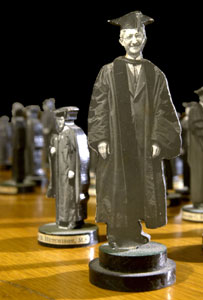The Academic Senate’s mysterious little men
Figurines of campus faculty from the late ’30s were meticulously crafted — but to what end?
![]()
| 10 September 2003
| |  Noah Berger photo |
Writer Dorothy Sayers’ prim Oxford alumna, Harriet Vane, encountered burnt effigies and menacing letters — and, of course, unraveled a mystery — during a visit to her alma mater in the novel Gaudy Night. But what would the discerning sleuth have made of a set of intricately crafted figurines — most of them Berkeley faculty of the late 1930s in full academic regalia — rediscovered in a wooden file cabinet?
It’s just such a trove that Maureen Morley, Academic Senate executive director, stumbled upon five years ago while moving into her Stephens Hall office. Inside a dusty envelope, Morley found 35 miniature scholars who, it turns out, had last been on display in the Senate office in the early ’90s. She found nothing more — no paraphernalia or verbiage indicating who-made-it, why, or when. Just an intriguing set of clues that have puzzled would-be gumshoes ever since.Senate Chair Ron Gronsky recalls stopping “dead in my tracks” the first time he saw the gaggle of tiny dons from yesteryear — Elmer Goldsworthy, Griffith Evans, Stuart Dagget and the rest — on a cabinet in the hallway. What struck Gronsky about the figurines is the personality each exudes — with a wry facial expression or a paunchy slouch — and the care that went into their construction. To make each piece, someone transferred the prof’s contours from a photograph onto a piece of thin wood, cut the wood with a scroll saw, laminated the photo onto the wooden backing, mounted the figure on a base, and painted the back and sides. Each also bears a label (name and academic degrees) and a year — 1937, 1938, or 1939 — or, in a few cases, the date May 20, 1939 or May 21, 1939. No casual project, clearly.
Hypotheses abound
Clues notwithstanding, a definitive explanation of the “little men,” as they’ve come to be called, is elusive. Even those steeped in campus lore — like the late Professor Robert Brentano (whose Berkeley career stretched back half a century), former University Archivist Bill Roberts, and Cal history buff Steve Finacom of Capital Projects — have been stumped.
“I can’t seem to draw any definitive conclusions,” confesses Finacom. Eager to discern some tell-tale pattern, he notes that the little men do include many “heavy hitters” from the first part of the 20th century, such as Charles Derleth, one-time engineering dean; UC Vice President and Provost Monroe Deutsch; and the much-respected head of psychology Edward Tolman. Many “were strong supporters of faculty independence…,” he observes, “well respected and appreciated by their faculty colleagues — not the ‘brilliant but really hard to get along with’ type.”
Unpersuaded, some think the figurines may have been used to plan commencement processionals. Others — noting that Stephens Hall housed ASUC activities back in the 1930s — believe they were created and used by students, possibly in an initiation rite or exorcism rituals. A few years ago, the Academic Senate held a contest on Cal Day, asking visitors to offer their own ideas. The winning entry, Morely recalls, featured invading aliens, miniaturization, and deportation via spaceship.
It should be noted that not all little men are created equal. The four tallest — mounted on weighted pedestals and measuring about four inches high — are W. Popper (etched with the number 1411), G.D. Louderback (a geology professor and L&S dean in the 1930s), J.J. Van Nostrand (a professor of ancient history and an active Senate member, bearing the date May 20, 1939, and the number 1395) and George M. Calhoun, a professor of classics. Their size “could indicate stature,” Gronsky speculates. “They were possibly used for campus battle planning.”
Another theory — the most popular to date — is that the models formed a chess set. According to this hypothesis, the four tall profs on double pedestals would have been kings and queens and the smallest an entourage of pawns. But how would players have kept straight which of the mid-sized pieces were bishops, rooks, and knights?
Newly noticed
Upon close inspection, Gronsky recently discovered an additional clue on the back of one Guy Montgomery, who chaired the English department in the 1930s — a tiny poem penned in faded ink. Assisted by microscopy in his materials science laboratory, he made out the following verse:
There was a saucy prairie dog
Alert upon his mound
With questing nose, with paws agog
He stood there looking round
As pert as any golliwog
And somewhat less profound.
The plot thickened when Gronsky found an obituary of Montgomery online. “He retained to the last,” it reads in part, “his sense of fun, his capacity to laugh with others and with himself, though the flashes of wit long famous on the campus ripened in his later years into a gentle glow.”
The homage, Gronsky said with excitement, “appears to sync with his poem.... That’s evidentiary material if I ever saw it!”
But leading to what conclusion?
To date, the Case of the Little Men of the Academic Senate remains unsolved. Do you have a new piece of evidence to offer, or a bit of Harriet or Sherlock in your veins? Contact the Berkeleyan — at berkeleyan@pa.urel.berkeley.edu — with any information or hypotheses. And be sure to let us know if you wish to remain anonymous.

